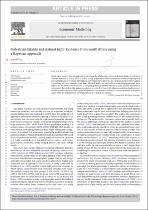 ResearchSpace
ResearchSpace
Pedestrian fatality and natural light: Evidence from South Africa using a Bayesian approach
JavaScript is disabled for your browser. Some features of this site may not work without it.
- ResearchSpace
- →
- Research Publications/Outputs
- →
- Journal Articles
- →
- View Item
| dc.contributor.author |
Das, Sonali

|
|
| dc.date.accessioned | 2014-08-27T12:39:39Z | |
| dc.date.available | 2014-08-27T12:39:39Z | |
| dc.date.issued | 2014-02 | |
| dc.identifier.citation | Das, S. 2014. Pedestrian fatality and natural light: Evidence from South Africa using a Bayesian approach. Economic Modelling, vol. 38, pp 311-315 | en_US |
| dc.identifier.issn | 0264-9993 | |
| dc.identifier.uri | http://ac.els-cdn.com/S0264999313005403/1-s2.0-S0264999313005403-main.pdf?_tid=d958cc9c-2dd3-11e4-aa52-00000aab0f26&acdnat=1409135043_cf7e37c21c46d8984a97a315b833934f | |
| dc.identifier.uri | http://hdl.handle.net/10204/7645 | |
| dc.description | Copyright: 2014 Elsevier. This is the pre/post print version. The definitive version is published in Economic Modelling, vol. 38, pp 311-315 | en_US |
| dc.description.abstract | In this paper we use a Bayesian approach to investigate the relationship between pedestrian fatality records from Tshwane and time of fatality. Time of fatality is used as a proxy to reflect the presence of effective lighting, not precluding the presence of any other lighting intervention. In South Africa, for a large proportion (60%) walking is a primary means of transport, with about 45% of all deaths on South African roads being pedestrian. Such reports call for attention to be devoted to analyzing pedestrian fatalities records to locate possible directions of intervention. Results fromthis analysis reveals that not only does time of day influence pedestrian fatality counts, but also within road types, municipal roads were the most prone to pedestrian fatalities followed by national roads, while the regional roads were the least prone to pedestrian fatalities. | en_US |
| dc.language.iso | en | en_US |
| dc.publisher | Elsevier | en_US |
| dc.relation.ispartofseries | Workflow;13242 | |
| dc.subject | Pedestrian fatality records | en_US |
| dc.subject | Bayesian approach | en_US |
| dc.subject | Natural light | en_US |
| dc.subject | Infrastructure improvements | en_US |
| dc.title | Pedestrian fatality and natural light: Evidence from South Africa using a Bayesian approach | en_US |
| dc.type | Article | en_US |
| dc.identifier.apacitation | Das, S. (2014). Pedestrian fatality and natural light: Evidence from South Africa using a Bayesian approach. http://hdl.handle.net/10204/7645 | en_ZA |
| dc.identifier.chicagocitation | Das, Sonali "Pedestrian fatality and natural light: Evidence from South Africa using a Bayesian approach." (2014) http://hdl.handle.net/10204/7645 | en_ZA |
| dc.identifier.vancouvercitation | Das S. Pedestrian fatality and natural light: Evidence from South Africa using a Bayesian approach. 2014; http://hdl.handle.net/10204/7645. | en_ZA |
| dc.identifier.ris | TY - Article AU - Das, Sonali AB - In this paper we use a Bayesian approach to investigate the relationship between pedestrian fatality records from Tshwane and time of fatality. Time of fatality is used as a proxy to reflect the presence of effective lighting, not precluding the presence of any other lighting intervention. In South Africa, for a large proportion (60%) walking is a primary means of transport, with about 45% of all deaths on South African roads being pedestrian. Such reports call for attention to be devoted to analyzing pedestrian fatalities records to locate possible directions of intervention. Results fromthis analysis reveals that not only does time of day influence pedestrian fatality counts, but also within road types, municipal roads were the most prone to pedestrian fatalities followed by national roads, while the regional roads were the least prone to pedestrian fatalities. DA - 2014-02 DB - ResearchSpace DP - CSIR KW - Pedestrian fatality records KW - Bayesian approach KW - Natural light KW - Infrastructure improvements LK - https://researchspace.csir.co.za PY - 2014 SM - 0264-9993 T1 - Pedestrian fatality and natural light: Evidence from South Africa using a Bayesian approach TI - Pedestrian fatality and natural light: Evidence from South Africa using a Bayesian approach UR - http://hdl.handle.net/10204/7645 ER - | en_ZA |





